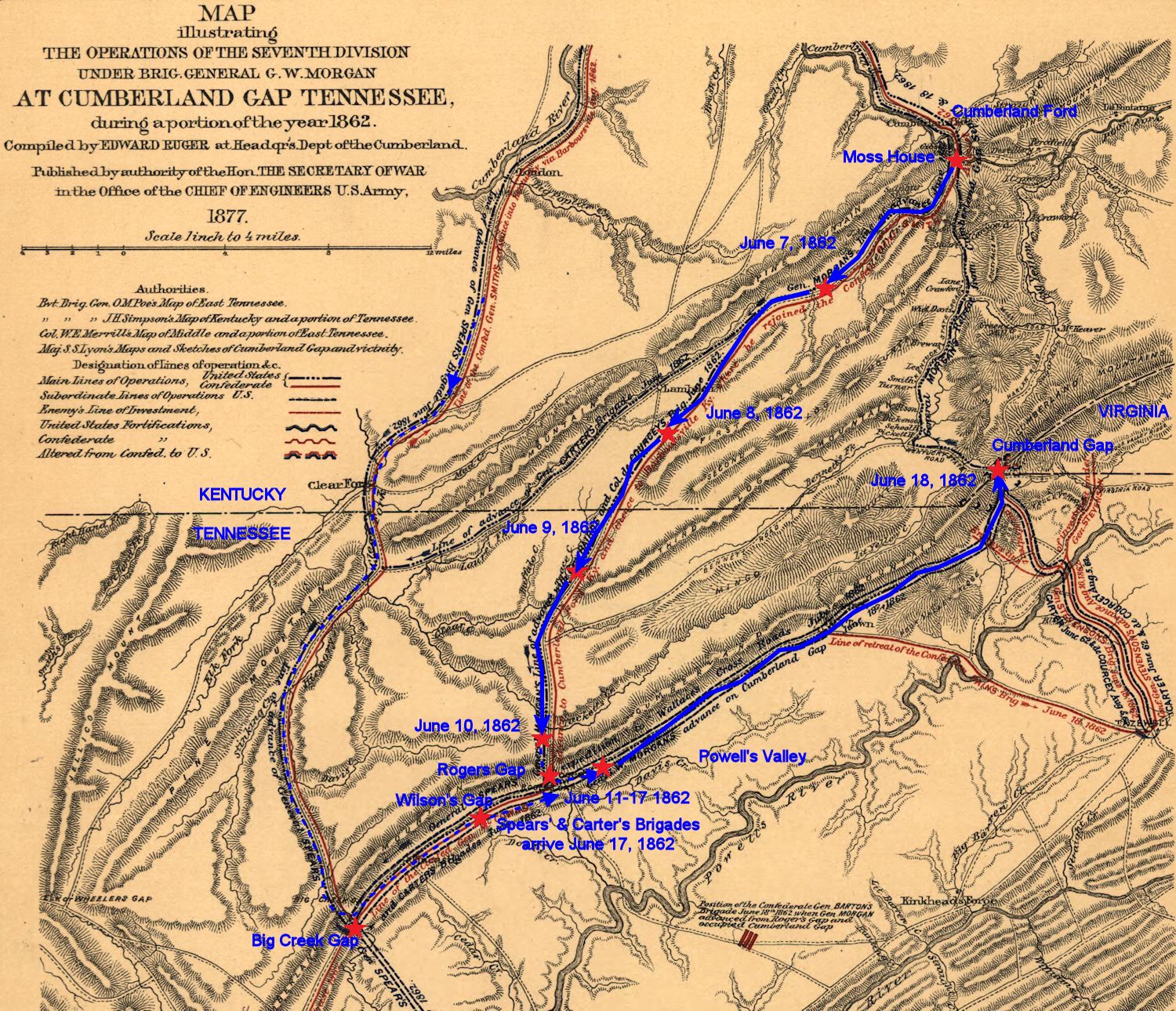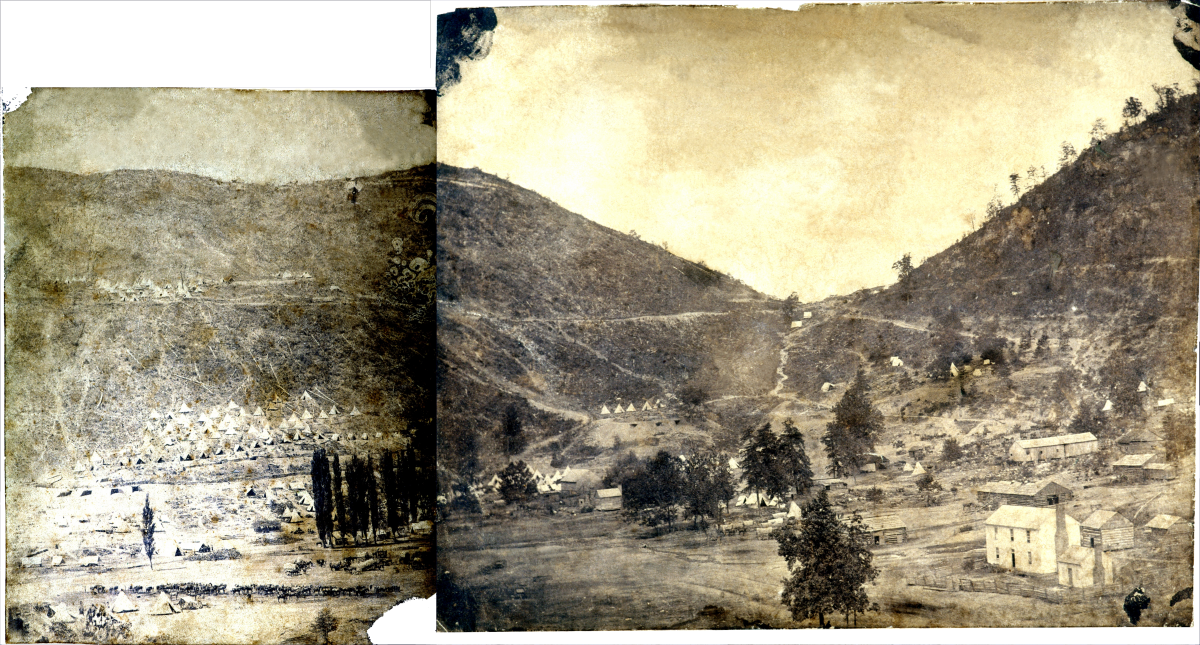| Previous Date | Day By Day Index | 16th OVI Home Page | Next Date |
Where was the regiment on
June 18, 1862
After spending seven days in Powell's Valley below Roger's Gap in the Cumberland Mountains of Tennessee, today the regiment, with Gen. George W. Morgan's division of four brigades, began their march up the valley toward Cumberland Gap. Cpl. Theodore Wolbach, Company E, tells us:
We headed up the Powell's Valley and rapidly marched toward the coveted Gap.
All through that pleasant June morning, with rapid and steady tread, we penetrated that lovely country. As the day was drawing to a close we espied the abandoned stronghold of Cumberland Gap, with the mountain shelves specked here and there with clusters of white tents just as their former occupants had left them but ripped from top to bottom and useless to us.
It was the evening of June 18th that closed the flank movement to the rear of Cumberland Gap, and culminated in its capture. For more than six months a force, whose strength was never accurately known to us, but undoubtedly equaled ours in numbers, occupied this stronghold and waited with patient solicitude for the attack that they expected would be made on the north side of the mountain. By an immense outlay of labor, strong rifle pits, batteries and palisades had been erected, and every approach was elaborately protected with abates. The rules of strategy had been so carefully studied in fortifying this gateway in the mountain, that to attempt to storm the works would have invited annihilation to the attacking force.
As the weary columns of Morgan's Division approached the Gap, they converged at the base of the mountain and stacked arms.
Pvt. Peter Perrine, Company C, records:
Marched at 2 oclock A.M. and arrived at Cumberland Gap at dark marching 21 miles. found the place evacuated & everything destroyed. We marched up into their works and fired a national Salute.
Paraphrased from Pvt. Frank Mason's (Company A, 42nd Ohio) description of the day:
At three o'clock in the morning Morgan's entire Division started marching east northeast by two parallel roads, so as to show the Confederates a more powerful force, toward Cumberland Gap. The roads were close enough to allow the columns to support each other if needed. At nine o'clock a.m. DeCourcey's brigade, leading the right hand column, passed through the abandoned camps of a Division of the enemy. This is where Gen. Morgan anticipated the Rebels would make a stand but they had fled.
The troops were now within sight of the Gap. The pace quickened and at noon, after a 21 mile march, they reached the road at the foot of the southern slope. Not one Confederate was found. The enemy had evacuated the Gap and destroyed everything of value. The Gap had been taken without firing a shot.
DeCourcey's troops marched up the Gap and took possession of the citadel. Each regiment was allowed to hoist their regimental colors over their newly taken prize. Lamphere's cannons were fired in salute of the Union victory. Kentucky, and the north were now safe from invasion through Cumberland Gap.
The remaining Brigades followed up the pass and before nightfall, the troops were posted behind the Rebel works, batteries set in position and Morgan was prepared to defend the Gap against any Confederate attack.
Morgan had moved his force and taken the Gap literally in the nick of time. The Rebel rear guard had not left until ten in the morning, just two hours before DeCourcey arrived. Confederate General Barton was approaching Roger's Gap from the east and was just three miles across Powell's River. If an engagement had occurred, it was highly likely the Confederates would have discovered the relative weakness of Morgan's force and countermanded the evacuation, possibly putting Morgan's entire force at risk. Achieving the high ground and fortifications now gave Morgan's smaller force a great advantage. It was later learned that Confederate General Kirby Smith did learn, on the morning of June 18th, a more accurate accounting of the size of the Union force. He immediately ordered his troops to re-occupy the Gap. When Smith's advance troops reached the foot of the Gap around dusk, within sight of the citadel, they could see the many Federal campfires all along the hills and knew they had missed their chance. Smith realized that only a siege could force the Union troops out of the Gap...
From the late headquarters of the Confederate commander, General Morgan sent his superior, General Buell, the good news and also his regrets for having disregarded Buell's implied order (to return to Kentucky). A few weeks later the following order was received from Buell who was headquartered at Huntsville, Alabama:
Headquarters Army of the Ohio
Huntsville, Ala. July 11th, 1862
GENERAL ORDER NO. 29
The General commanding the Army of the Ohio, takes pleasure in announcing the success of an arduous and hazardous campaign by the Seventh Division, Brig. Gen. Geo. W. Morgan commanding, by which the enemy's fortified position at Cumberland Gap was turned and his forces compelled to retreat, as our troops advanced to attack. The General commanding thanks Gen. Morgan and the troops of the Seventh Division for the ability displayed in the operations against this important stronghold, and for the energy, fortitude and cheerfulness which they exhibited in their struggle with difficulties of the most formidable magnitude for an army.
By command of Major-General Buell.
Jas. B. Fry,
Colonel and Chief of Staff.
Just four days after Morgan's victory he received the recognition and praise of President Lincoln and Secretary of War, Stanton:
Washington, June 22d, 1862
Brigadier-General Geo. W. Morgan
This Department has been highly gratified with your successful occupation of Cumberland Gap, and commend the gallant conduct of your officers and troops, to whom you will express the thanks of the President and the Department. With thanks for your diligence and activity,
I remain, Yours truly,
E. M. Stanton,
Secretary of War.
The 16th Ohio now settled down to camp life having been a key participant in the near miraculous accomplishment of outwitting the Confederates, crossing the Cumberland Mountains at a previously thought impossible spot and occupying The Gap without a single shot being fired and with no loss of life.
Information and some paraphrasing, above, taken from The Forty-Second Ohio Infantry - A History of the Organization and Services of That Regiment In the War of the Rebellion, 1876 - F. H. Mason, late Private of Company A - Cobb, Andrews & Co., Publishers.


| Previous Date | Day By Day Index | 16th OVI Home Page | Next Date |